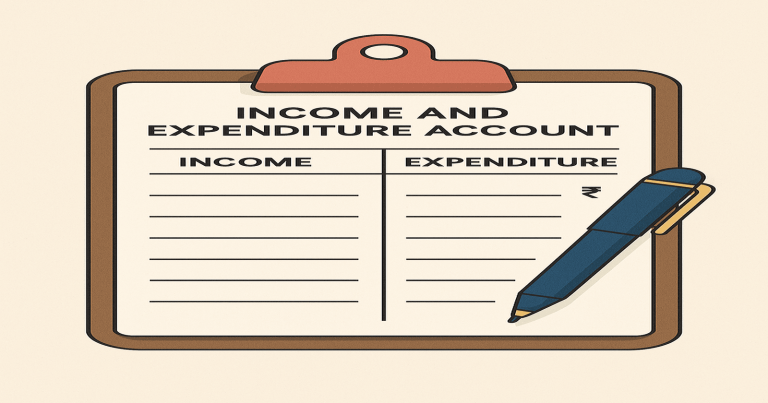The income and expenditure account format is a very vital financial statement employed mainly by non-profit organizations, clubs, and societies. The statement is meant to evaluate the financial performance of these organizations for a particular period. In contrast to profit-making businesses that make use of profit and loss accounts, non-profit organizations employ income and expenditure accounts to establish whether they have realized a surplus or deficit. This account captures all the revenues (income) and expenses (expenditure) incurred by the organization within the financial year, giving a clear picture of the financial condition of the organization.
What is an Income and Expenditure Account?
An income and expenditure account is a financial statement that records the revenues and expenses of non-profit organizations over a particular period. It is similar to a profit and loss account used by for-profit entities. Still, its primary aim is not to calculate profit but to determine if the organization has a surplus (excess of income over expenditure) or a deficit (excess of expenditure over income).
This account is prepared using the accrual basis of accounting, meaning that income and expenses are recognized when they are earned or incurred, not when cash is received or paid. It helps in analyzing whether the non-profit organization has effectively managed its financial resources and met its goals within the period.
Surplus and Deficit Balance of an Income and Expenditure Account
The surplus and deficit balance of an income and expenditure account is the final result of comparing total income with total expenditure over a specific period.
- Surplus: A surplus occurs when total income exceeds total expenditure. This indicates that the organization has managed its resources well, allowing it to save or reinvest excess funds for future operations or projects. Example: A charity organization that collects more donations than it spends on its programs and administrative costs will report a surplus.
- Deficit: Deficit occurs when total expenditure is higher than total income. This indicates that the organization has expended more than it generated during the period, which may need to be covered by fundraising, expense reduction, or financial re-planning.Example: A non-profit running a deficit might have overspent on a major event without raising enough sponsorship or donations to cover the costs.
Basic Features of an Income and Expenditure Account
The basic features of an income and expenditure account are what makes it distinct from other financial statements. Here are some important characteristics:
- Accrual Accounting: As noted above, the income and expenditure account accords with the accrual basis of accounting. This implies that transactions are accrued when they take place, irrespective of when the cash is actually exchanged.
- Excludes Capital Transactions: Capital transactions like the acquisition or disposal of fixed assets, loans, and advances are not included in this account. They are posted in a different balance sheet.
- Non-Profit Specific: It is used specifically by non-profit entities like clubs, societies, and charitable institutions to track how well they are managing their resources.
- Revenue and Expense Focus: It records only revenue (income) items such as membership fees, subscriptions, grants, and expenses related to running the organization, including operational and administrative costs.
- Adjustments for Outstanding and Prepaid Items: Adjustments are made for any income that is yet to be received or expenses that have been incurred but not paid. Similarly, prepaid expenses and accrued incomes are accounted for.
- Surplus or Deficit Determination: At the end of the accounting period, the account shows whether there is a surplus (income exceeds expenditure) or a deficit (expenditure exceeds income), providing insight into the financial status of the organization.
How do you prepare an income and expenditure account?
This format gives a concise, structured method to monitor income and expenditure. To know how to make an income and expenditure account, follow these steps:
Step 1: Begin with the Opening Balance Sheet: Begin with the reviewing of the balance sheet at the beginning of the accounting period, noting all liabilities and assets.
Step 2: List All Incomes: Take all income sources, including membership fees, subscription, donations, government grants, and other incomes collected over the accounting period. Make adjustments for any income that has yet to be collected or that was collected in advance (prepaid).
Step 3: List All Expenses: Account for all operating expenses like salaries, office space rent, utilities, program expenses, and administrative charges. Add accrued expenses (expenses incurred but not yet paid) and deduct prepaid expenses.
Step 4: Exclude Capital Transactions: Make sure all capital receipts (e.g., loan or sale of assets) and capital payments (e.g., purchase of assets or loan repayments) do not count in the income and expenditure account. They are under the balance sheet.
Step 5: Calculate the Surplus or Deficit: Subtract the sum of the expenses from the sum of the income. A positive answer is a surplus, while a negative answer is a deficit.
Step 6: Record Adjustments: Record required adjustments for depreciation of tangible assets or amortization of intangibles.
Example of Income and Expenditure Account Format:
What Comes in an Income and Expenditure Account?
This account includes all revenue-related items that a non-profit organization earns or spends during a financial period. These elements are carefully tracked to determine whether the organization has a financial surplus or deficit at the end of the period. Below are the key components:
Income
- Membership Fees/Subscriptions: Recurring fees paid by members to maintain their membership in the organization.
- Donations: Contributions made by individuals, businesses, or other organizations.
- Grants: Funds provided by government bodies or private institutions to support specific projects or general operations.
- Interest Earned: Interest earned on bank accounts or investments.
- Miscellaneous Income: Income from events, sales, or any other minor revenue streams.
Expenditure
- Salaries and Wages: Payment to staff members and workers.
- Rent and Utilities: Office rent, electricity, water, and other utilities.
- Administrative Expenses: Office supplies, printing, and general office expenses.
- Program Expenses: Costs related to running specific programs or events.
- Depreciation: Accounting for the reduction in value of tangible fixed assets
Income and Expenditure Account Format FAQs
What is an income and expenditure account?
It is a financial statement that records the revenues and expenses of non-profit organizations to determine whether they have a surplus or deficit.
What is the purpose of an income and expenditure account?
Its purpose is to assess the financial performance of a non-profit organization over a specific period by comparing total income with total expenditure.
How is surplus or deficit calculated?
The surplus is calculated when total income exceeds total expenditure, while a deficit is recorded when expenditure exceeds income.
What are the basic features of an income and expenditure account?
It uses accrual accounting, excludes capital transactions, and focuses on revenues and expenses incurred during a specific period.
What comes in an income and expenditure account?
It includes income sources like subscriptions, donations, and grants, as well as expenses such as salaries, rent, utilities, and program costs.


